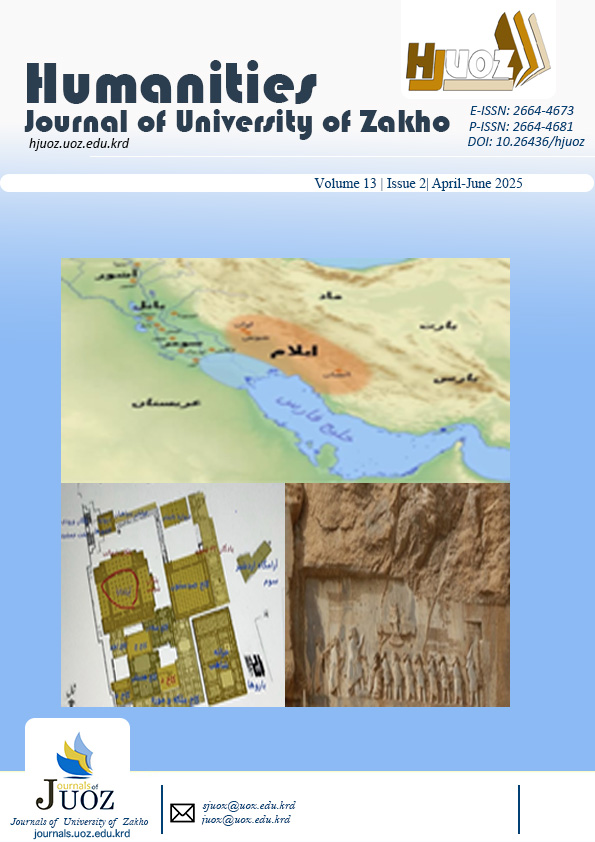THE RELATIONSHIP BETWEEN (ORIGIN, SCIENTIFIC PART AND LANGUAGE OF STUDY) AND USING EMOJIS BETWEEN THE STUDENTS OF THE UNIVERSITY OF ZAKHO
DOI:
https://doi.org/10.26436/hjuoz.2025.13.2.1597Keywords:
Social Media, Emojis, Message, Linguistic Symbols, None Linguistic SymbolsAbstract
Emojis are the symbols that join writing symbols in social media. And they are also a part from what a message of someone carries. Someone who message others tends to use them for expressing a case or expressing an excitement or for abbreviating words, to write a little speech and also they use them for decorating the appearance of the speech, influence and avoiding mystery on the message. This study has been done under the title “ the relationship between (origin, scientific part and language of study) and using emojis between the students of the university of Zakho”. It seeks to answer this main question: do (origin, scientific part and study of language) variables have a relationship with the type of emojis? The study has been done in a questioning manner with 120 students from the university of Zakho of origin, scientific part and study of language differently and the data has been explained by SPSS program. The main hypothesis of the study is that the mentioned variables have relationship with choosing the type of emojis. After taking data’s and explaining them it was clear that origin and scientific part have relationship with choosing the type of emojis, but language of study doesn’t have any relationship with it.
Downloads
References
رهئوف، لوقمان. (2016). دهقى شىعرى كوردى ل ڕۆانگهى سيميۆلۆژييهوه (1950-1975) كرمانجى خواروو. دهزگاى ئايدييا بۆ فكرو لێكۆڵينهوه.
عهبدوللا A، عهبدولسهلام نهجمهدين. (2018). شڕۆڤهكرنا زمانێ ڕيكلامێن بازرگانى. زاخۆ: سهنتهرێ زاخۆ بۆ ڤهكۆلينێن كوردى.
عهبدوللا B، عهبدولسهلام نهجمهدين. (2008). شيكردنهوهى دهقى شيعرى له ڕووى زمانهوانييهوه. دهۆك: دهزگههێ سپيرێز يێ چاپ و وهشانێ.
عهبدوللا، عهبدولسهلام نهجمهدين و عهلى، شێرزاد سهبرى. (2011). زمانڤانييا تيۆرى. دهۆك: دهزگههێ سپيرێز يێ چاپ و وهشانێ.
عهلى، شێرزاد سهبر. (2011). واتا دناڤبهرا سيمانتيك و پراگماتيكێدا. دهۆك: دهزگههێ سپيڕيز يێ چاپ و وهشانێ.
مشهختى، كامهران ئيبراهيم. (2011). سيمۆلۆژيايى زمانى سۆفيگهرى له شيعرهكانى مهلاى جزيريدا. دهۆك: دهزگههێ سپيرێز يێ چاپ و وهشانێ.
زيتوني، خديجة، و حدباوي، فاطمة الزهراء. (2016/2017). أثر استخدام الرموز التعبيرية في شبكات التواصل الاجتماعي على اللغة الفيس بوك أنموذجا. الجزائير: جامعة محمد بوضیاف _المسیلة.
پروين فغفورى آذر و ديگران. (پاییز 1402) بررسى كاركردهاى زبانى ايموجى ها در شبكه اجتماعى توئيتر، فصلنامه زبانشناسی اجتماعی، دوره ششم (سری جدید)، شمارۀ 4، پیاپی 24، صص 1-11.
پروين فغفورى آذر و غلامرضا آذرى. (تابستان 1401). بررسی کنش های غیرکلامی در توئیت های حاوی ایموجی کاربران ایرانی توئیتر بر اساس نظریه سرل، فصلنامۀ رهپویۀ ارتباطات و فرهنگ، دورۀ اول، شمارۀ چهارم، صص 95- 103.
رضا كاظميان. (تابستان 1400). بررسی تفاو ت های جنسیتی و سنی در کاربرد ایموجی و علل ترجیح آن بر ایموتیکان میان کاربران ایرانی، فصلنامه مطالعات رسانههاى نوين، سال هفتم، شمارة 62، صص 239-266.
سارا خندابى و عفت السادات افضل طوسى. (پاییز 1402). بررسی استفاده از ایموجی در هنر معاصر بر مبنای آرای لیندا هاچن درباره پارودی، فصلنامه علمی دانشگاه الزهرا (س) زمینه انتشار: هنر، سال 15 ، شماره 3، صص 40-57.
عليرضا دهقان و ديگران. (پاییز 1395). مطالعه استیکرهاى وایبر و نشانهشناسی ایدئولوژيهاى آن، فصلنامه مطالعات رسانه هاى نوین، سال دوم، شماره 7، صص 1-33.
مارسا دانسى. (1399). نشانهشناسى ايموجۆ - پيداش يك زبان تصويرى در عصر اينترنت، ترجمه: محمد مهدى فتوحى رشيدى و محمد امين قاسمى پيربلوطى، دانشگاه امام صادق (ع)، تهران.
محمدصادق نصراللهی و محمدجواد بادین فکر. (بهار 1398). نشانه شناسی فرهنگی-ارتباطی ایموجی ها در پیامرسانهاى اجتماعی، مورد مطالعۀ فرهنگ خانواده، فرهنگ جنسی و فرهنگ زبان دست، فصلنامه مطالعات رسانههاى نوین، سال پنجم، شماره 17 ، صص71-105.
Alonso, D. H. (n.d.). emojitimeline. Retrieved 30 1, 2021, from https://emojitimeline.com/
Alshenqeeti, H. (2016, December ). Are Emojis Creating a New or Old Visual Language for New Generations? A Socio-semiotic Study. Advances in Language and Literary Studies, 7(2203-4714), pp. 56-69. doi:Doi:10.7575/aiac.alls.v.7n.6p.56
Bai, Q., & Yang, M. (2019, October 15). A Systematic Review of Emoji: Current Research and Future Perspectives. Front. Psychol, 10. doi:10.3389/fpsyg.2019.02221
Bakir, S. N., & Haji, H. H. (2019, February). The Use of Emoticons among University Students: A Pragmatic Study. Zanco Journal of Human Sciences (ZJHS) (1), pp. 278-290. doi:https://doi.org/10.21271/zjhs.23.1.19
Bosch, O. J., & Revilla, M. (2018, July). The use of emojis by Millennials. Research and Expertise Centre for Survey Methodology (RECSM), pp. 1-26.
Buchholz, K. (2020, September 30). The history of the 5 billion emojis used every single day. Retrieved 1 30, 2021, from weforum: www.weforum.org
Dürscheid, C., & Siever, C. M. (2017, March 29). Beyond the Alphabet – Communication with Emojis. reseachGafe.
Emoji and Sticker Compared. (n.d.). Usage of emojis as compared to stickers. Retrieved 30 1, 2021, from stackexchange: https://ux.stackexchange.com/questions/98855/usage-of-emojis-as-compared-to-stickers
emojipedia. (n.d.). Retrieved 30 1, 2021, from https://emojipedia.org/unicode-6.0
Face with Tears of Joy. (n.d.). Retrieved 1 29, 2021, from emojipedia: https://emojipedia.org/face-with-tears-of-joy/
Galloway, P. (2016, October 26). The Original NTT DOCOMO Emoji Set Has Been Added to The Museum of Modern Art’s Collection. Retrieved 1 29, 2021, from https://stories.moma.org/the-original-emoji-set
Kumar, N., & Thollander, P. K. (2019, May 4-9). Examining the “Global” Language of Emojis: Designing for Cultural Representation. CHI 2019.
Persson, N. (2018, Autumn 18). Analysis of Emoji Usage: Differences in Preference and Function Across Genders. Jonkopink University.
Prisco, J. (2018, May 23). Shigetaka Kurita: The man who invented emoji. Retrieved 1 29, 2021, from CNN: https://edition.cnn.com/style/article/emoji
unicode. (2021, 1 5). Full Emoji List, v13.1. Retrieved 30 1, 2021, from unicode: https://unicode.org/emoji/charts/full-emoji-list.html
Downloads
Published
How to Cite
Issue
Section
License
Copyright (c) 2025 Salwa F. Salih, Warhel A. Kamel

This work is licensed under a Creative Commons Attribution-NonCommercial-ShareAlike 4.0 International License.
Authors who publish with this journal agree to the following terms:
- Authors retain copyright and grant the journal right of first publication with the work simultaneously licensed under a Creative Commons Attribution License [CC BY-NC-SA 4.0] that allows others to share the work with an acknowledgment of the work's authorship and initial publication in this journal.
- Authors are able to enter into separate, additional contractual arrangements for the non-exclusive distribution of the journal's published version of the work, with an acknowledgment of its initial publication in this journal.
- Authors are permitted and encouraged to post their work online.

















